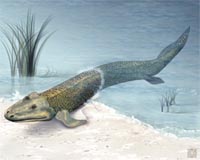| . |  |
. |
Florence, Ore. (UPI) Jan 7, 2009 About 2,000 sea lions spotted off the central Oregon coast may be the popular marine mammals that disappeared from San Francisco's piers, wildlife experts say. The sea lions may have simply left their Fisherman's Wharf hangout to follow their food to colder water, the experts say. "We've seen these huge pods out on the ocean -- 200, 300 yards across -- altogether a couple thousand sea lions," said Steve Saubert, co-owner of Sea Lion Caves, a connected system of sea caves and caverns open to the Pacific Ocean near Florence, Ore. About 500 of the sea lions moved into the caves in the past week or two, Jim McMillan, an assistant manager at the cave preserve, told the San Francisco Chronicle. Saubert, 66, said California sea lions, as well as Steller sea lions, which are threatened, have been attracted to the area by an influx of cold water -- about 51 degrees -- and food, including herring, anchovies, smelt and squid. The cold water has also attracted pelicans and other marine birds, he said. Saubert told the newspaper this summer's El Nino event characterized by a warming of surface waters along the California coast pushed the food north and the wildlife followed. Biologists noted a shortage of herring in San Francisco Bay and along the Northern California coast. The Marine Mammal Center near San Francisco counted a high of 1,701 sea lions at San Francisco's Pier 39 shopping and tourist attraction Oct. 23. The number dropped to 927 Nov. 21 and was just a half-dozen last week. Sea Lion Caves is one of the great sea grottoes of the world, comparable in size and coloration to the famed Blue Grotto on the coast of the island of Capri, Italy. The caves contain a wide variety of marine life.
Share This Article With Planet Earth
Related Links Darwin Today At TerraDaily.com
 Oldest tetrapod tracks found in Poland
Oldest tetrapod tracks found in PolandKielce, Poland (UPI) Jan 6, 2009 The world's oldest tetrapod prints have been discovered in the Holy Cross Mountains of southeastern Poland, paleontologists said. The prints of the tetrapods -- four-legged animals -- are 18 million years older than previously confirmed findings of tetrapod tracks, said Per Ahlberg, a paleontologist at Uppsala University, Sweden. Ahlberg and his colleagues found fossilized prints ... read more |
|
| The content herein, unless otherwise known to be public domain, are Copyright 1995-2009 - SpaceDaily. AFP and UPI Wire Stories are copyright Agence France-Presse and United Press International. ESA Portal Reports are copyright European Space Agency. All NASA sourced material is public domain. Additional copyrights may apply in whole or part to other bona fide parties. Advertising does not imply endorsement,agreement or approval of any opinions, statements or information provided by SpaceDaily on any Web page published or hosted by SpaceDaily. Privacy Statement |